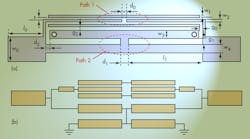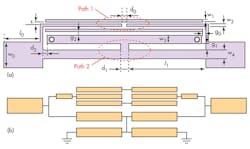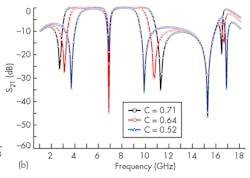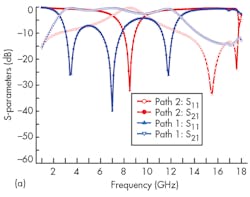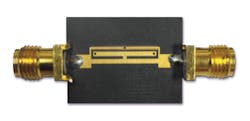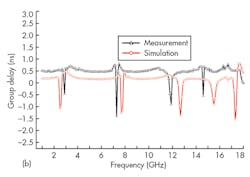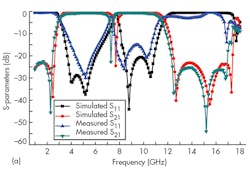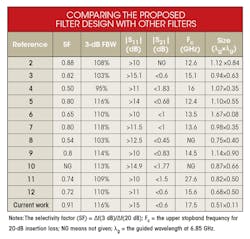UWB Bandpass Filter Includes Notched Band
This file type includes high-resolution graphics and schematics when applicable.
Development of ultrawideband (UWB) communications systems requires the design of many different component functions, including bandpass filters (BPFs) with acceptable selectivity. To serve UWB communications applications, a compact UWB BPF with reasonable selectivity and an integral notched band was fabricated with two interdigital, coupled, three-line structures. Selectivity was improved by adding another signal path loaded by two short-circuit stubs. The filter exhibits sharp rolloff to its rejection bands with a wide fractional bandwidth of 116%, with 25-dB rejection in the notched band.
The UWB spectrum from 3.1 to 10.6 GHz has attracted lots of attention in recent years due to its excellent energy efficiency—it supports short-range transmission of very high data rates while only requiring very low power levels. This spectrum was authorized for commercial radio use at low transmit levels in 2002.1
A great deal of research has been reported on efforts to develop BPFs with high selectivity for UWB use while achieving wide stopband, low insertion loss, and compact size.2-12 One approach, with three coupled interdigital transmission lines, has proven popular in recent UWB BPF designs.2,3
Other UWB BPF design approaches involve the use of transitions between different microwave transmission lines, such as microstrip and coplanar waveguide (CPW). These UWB BPFs have incorporated both CPW-to-microstrip transitions4 and microstrip-to-CPW transitions.5 In ref. 6, a new approach involving a bandpass defected microstrip resonator was used to implement an UWB BPF.
Because UWB signals are used at such low levels over such wide bandwidths, interfering signals are inevitable, leading to the development of various methods to create a notched band within the passband of an UWB BPF.7-12 For example, an L-shaped open-end slot was inserted in a trisection-stepped-impedance-resonator (TSSIR) to generate a notched band at 5.5 GHz.7 In ref. 8, a parasitic coupled line was added to achieve an UWB BPF with a notched band. In ref. 9, a microstrip-to-stripline transition was used in the UWB BPF, and a microstrip stub located at the feedlines helped to reject wireless-local-area-network (WLAN) signals within the UWB frequency range.
In ref. 10, a slow-wave, half-mode, substrate-integrated-waveguide (SW-HMSIW) UWB BPF design achieved a notched band through the use of an L-type resonator. More recently, several novel structures were reported to implement a notch band, such as the via-loaded ring resonators11 and a spiral defected ground structure.12
Design Details
To achieve good selectivity over the wide UWB frequency range, a BPF with a novel structure based on three interdigital coupled lines was developed (Fig. 1). To facilitate the design process, an equivalent-circuit transmission-line model was constructed using the Advanced Design System 2009 (ADS 2009) computer-aided-engineering (CAE) simulation software from Agilent Technologies (now Keysight Technologies).
Compared with traditional UWB BPFs based on the interdigital coupled three-line structures, the proposed filter offers improvements in terms of selectivity, small size, and low insertion loss. The filter also achieves a notched band at 7.3 GHz with a maximum rejection loss of 25 dB. A prototype was fabricated and measured using commercial test equipment, with test results matching closely with the computer simulations.
Figure 1 shows the basic structure of the UWB BPF and its equivalent-circuit transmission-line model. Input signals travel through two different signal paths. The filter’s main transmission path consists of two interdigital coupled three-line structures. The other signal path is a transmission line loaded with two short-circuited stubs.
As the simulations of paths 1 and 2 show in Fig. 2a, the interdigital coupled three-line structures of path 1 exhibit bandpass characteristics. These characteristics are not directly usable for UWB filtering because of unsatisfactory out-of-band characteristics like poor selectivity and narrow upper stopband. Additional filtering is provided by the transmission line loaded by the two short-circuited stubs (path 2), which functions as a narrow bandpass filter.
To simplify analysis, as detailed in ref. 13, the three interdigital coupled lines can be converted to an asymmetric parallel coupled-line structure. For convenience’s sake with respect to the filter design, its equivalent circuits (Fig. 3) are analyzed by ADS 2009. The simulated results of the equivalent circuits with different coupling coefficients are shown in Fig. 2b. In this work, its coupling coefficient of coupled lines is 0.64 due to limitations of manufacturing technology and the requirement of UWB. The optimized parameters for the proposed filter using ADS software were as follows:
Z1 = 143 â¦
Z2 = 93 â¦
Z3 = 93 â¦
θ1 = 26 deg.
θ2 = 90 deg.
θ3 = 90 deg.
Zoo = 62 â¦
Zoe = 278 â¦
θ4 = 90 deg.
Introducing the transmission line with two stubs generates two transmission zeros around the passband edges, significantly improving the UWB BPF selectivity. Moreover, a notched band at the passband center frequency is obtained.
Finally, according to parameters provided by ADS 2009, an UWB BPF was fabricated on RT/duroid 5880 from Rogers Corp. for experimental analysis. The circuit material has a dielectric constant (relative permittivity) of 2.2 measured at 10 GHz in the z-axis (thickness); circuit materials with 0.787-mm thickness were used for the filter.
Figure 4 presents a photograph of the fabricated UWB BPF. The filter was assembled according to the following parameters, developed with the aid of the ANSYS High Frequency Structure Simulator (HFSS) electromagnetic (EM) simulation software (V 13) from ANSYS:
w0 = 2.4 mm
l0 = 4 mm
s = 0.1 mm
d2 = 0.425 mm
g2 = 0.35 mm
d0 = 0.45 mm
w1 = 0.1 mm
w2 = 0.25 mm
g0 = 0.15 mm
g1 = 0.35 mm
w3 = 0.8 mm
d1 = 0.7 mm
l1 = 7.03 mm
w4 = 0.8 mm
Test Results
The S-parameters of the fabricated filter were obtained through measurements with a model E8383B vector network analyzer (VNA) from Agilent Technologies (again, now Keysight Technologies). As shown in Fig. 5, good consistency between the simulation and experiment results is observed except for the tiny frequency shift mainly caused by the machining and assemblage errors.
The measured results reveal that this filter achieves a very wide fractional bandwidth of 116% (3.05 to 11.4 GHz) with good return loss. Besides, this filter has a low insertion loss (>0.6 dB) within the passband. Obviously, it achieved sharp selectivity due to the transmission zeros at the lower and upper passband edges, respectively. Moreover, a notched band with a maximum rejection loss of 25 dB at 7.3 GHz was obtained. The group delay is relatively flat across the full UWB passband, with 0.25 ns or less variation (not including the notched band).
The table compares the performance of this UWB BPF with notched band to other UWB filters reported in the technical literature. Looking at the table, this novel UWB BPF has lower insertion loss, more compact size, wider passband bandwidth, and somewhat sharper selectivity.
The compact UWB filter shows measured performance that compares favorably with the best published results for UWB BPFs, including good selectivity, low insertion loss (>0.6 dB), compact size (0.51λg × 0.11 λg), good return loss (<15 dB), and wide bandwidth (3.05 to 11.4 GHz). Such performance levels make it a likely candidate for UWB communications systems, especially when the notched band can be applied to diminish the effects of troublesome interference within the UWB frequency range.
Acknowledgments
This work was supported by the National Natural Science Foundation of China under Grant 61471093 and the China Postdoctoral Science Foundation under Grant 2014M552337.
Xia Xinlin is Master, Yu Liu is Doctor/Associate Professor, and Yang Tao is Doctor/Associate Professor at the University of Electronic Science and Technology of China, School of Electronic Engineering, Chengdu, Sichuan 611731, People’s Republic of China.
References
1. Federal Communications Commission, “Revision of part 15 of the commission’s rules regarding ultra-wideband transmission systems,” First Report and Order, FCC 02. V48, April 2002.
2. X. Chen, L. Zhang, and Y. Peng, “UWB bandpass filter with sharp rejection and narrow notched band,” Electronic Letters, Vol. 50, No. 15, 2014, pp. 1,079-1,080.
3. X. Lu, B. Wei, Z. Xu, B. Cao, X. Guo, X. Zhang, R. Wang, and F. Song, “Superconducting Ultra-Wideband (UWB) Bandpass Filter Design Based on Quintuple/Quadruple/Triple-Mode Resonator,” IEEE Transactions on Microwave Theory & Techniques, Vol. 63, No. 4, 2015, pp. 1281-1293.
4. H. Hu, X. Huang, and C. Cheng, “Ultra-wideband bandpass filter using CPW-to-microstrip coupling structure,” Electronic Letters, Vol. 42, No. 10, 2006, pp. 586-587.
5. A. Ghazali, M. Sazid, and S. Pal, “Compact broadband balun-based UWB-BPF with minimum insertion loss and sharp selectivity,” Electronic Letters, Vol. 51, No. 15, 2015, pp. 1,174-1,175.
6. S. Fallahzadeh and M. Tayarani, “A New Microstrip UWB Bandpass Filter Using Defected Microstrip Structures,” Journal of Electromagnetic Waves and Applications, Vol. 24, No. 7, 2010, pp. 893-902.
7. C.-H. Lee, C.-I. G. Hsu, and L.-H. Chen, “Band-notched ultra-wideband bandpass filter design using combined modified quarter-wavelength tri-section stepped-impedance resonator,” IET Microwave Antennas & Propagation, Vol. 3, No. 8, 2009, pp. 1,232-1,236.
8. S. Pirani, J. Nourinia, and C. Ghobadi, “Band-Notched UWB BPF Design Using Parasitic Coupled Line,” IEEE Microwave & Wireless Component Letters, Vol. 20, No. 8, 2010, pp. 444–446.
9. C.-H. Lee, C.-I.G. Hsu, and C.-J. Chen, “Band-Notched Balanced UWB BPF With Stepped-Impedance Slotline Multi-Mode Resonator,” IEEE Microwave & Wireless Component Letters, Vol. 22, No. 4, 2012, pp. 182-184.
10. J. Li, C. Ding, F. Wei, and X. Shi, “Compact UWB BPF with notch band based on SW-HMSIW,” Electronic Letters, Vol. 51, No. 17, 2015, pp. 1,338–1,339.
11. H. Zhu and Q.-X. Chu, “Ultra-Wideband Bandpass Filter With a Notch-Band Using Stub-Loaded Ring Resonator,” IEEE Microwave & Wireless Component Letters, Vol. 23, No. 7, 2013, pp. 341-343.
12. G. Karimi, K.-H. Farnaz, and H. Siahkamari, “Compact UWB BPF using slotted resonator with an independently controllable notched band,” International Journal of Microwave &Wireless Technology, Vol. 8, No. 1, 2016, pp. 25-31.
13. M.-H. Weng, C.-T. Liauh, H.-W. Wu, and S. Vargas, “An Ultra-Wideband Bandpass Filter With an Embedded Open-Circuited Stub Structure to Improve In-Band Performance,” IEEE Microwave & Wireless Component Letters, Vol. 19, No. 3, 2009, pp. 146-148.
